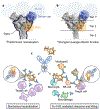Antibody-mediated protection against Ebola virus
- PMID: 30333617
- PMCID: PMC6814399
- DOI: 10.1038/s41590-018-0233-9
Antibody-mediated protection against Ebola virus
Abstract
Recent Ebola virus disease epidemics have highlighted the need for effective vaccines and therapeutics to prevent future outbreaks. Antibodies are clearly critical for control of this deadly disease; however, the specific mechanisms of action of protective antibodies have yet to be defined. In this Perspective we discuss the antibody features that correlate with in vivo protection during infection with Ebola virus, based on the results of a systematic and comprehensive study of antibodies directed against this virus. Although neutralization activity mediated by the Fab domains of the antibody is strongly correlated with protection, recruitment of immune effector functions by the Fc domain has also emerged as a complementary, and sometimes alternative, route to protection. For a subset of antibodies, Fc-mediated clearance and killing of infected cells seems to be the main driver of protection after exposure and mirrors observations in vaccination studies. Continued analysis of antibodies that achieve protection partially or wholly through Fc-mediated functions, the precise functions required, the intersection with specificity and the importance of these functions in different animal models is needed to identify and begin to capitalize on Fc-mediated protection in vaccines and therapeutics alike.
Conflict of interest statement
COMPETING FINANCIAL INTERESTS
The authors declare no competing interests.
Figures





References
-
- Carter PJ & Lazar GA Next generation antibody drugs: pursuit of the ‘high-hanging fruit’. Nat. Rev. Drug Discov 17, 197–223 (2018). - PubMed
Publication types
MeSH terms
Substances
Grants and funding
LinkOut - more resources
Full Text Sources
Other Literature Sources
Medical

